高中英语语法倒装句
- 格式:ppt
- 大小:158.00 KB
- 文档页数:11
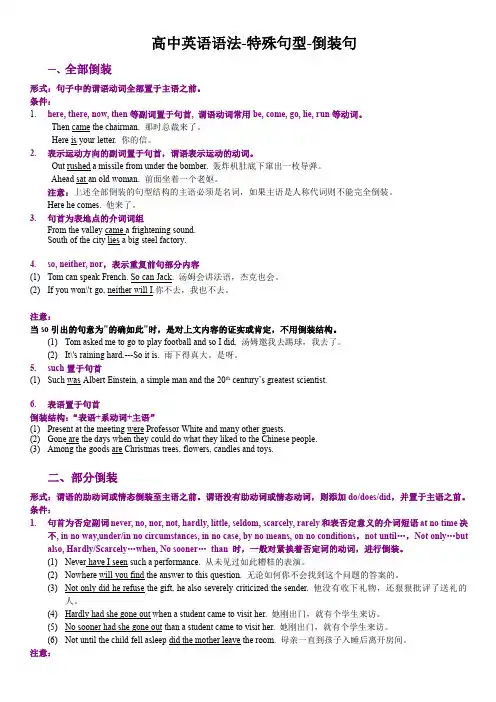
高中英语语法-特殊句型-倒装句一、全部倒装形式:句子中的谓语动词全部置于主语之前。
条件:1.here,there,now,then等副词置于句首,谓语动词常用be,come,go,lie,run等动词。
Then came the chairman.那时总裁来了。
Here is your letter.你的信。
2.表示运动方向的副词置于句首,谓语表示运动的动词。
Out rushed a missile from under the bomber.轰炸机肚底下窜出一枚导弹。
Ahead sat an old woman.前面坐着一个老妪。
注意:上述全部倒装的句型结构的主语必须是名词,如果主语是人称代词则不能完全倒装。
Here he comes.他来了。
3.句首为表地点的介词词组From the valley came a frightening sound.South of the city lies a big steel factory.4.so,neither,nor,表示重复前句部分内容(1)Tom can speak French.So can Jack.汤姆会讲法语,杰克也会。
(2)If you won\'t go,neither will I.你不去,我也不去。
注意:当so引出的句意为"的确如此"时,是对上文内容的证实或肯定,不用倒装结构。
(1)Tom asked me to go to play football and so I did.汤姆邀我去踢球,我去了。
(2)It\'s raining hard.---So it is.雨下得真大。
是呀。
5.such置于句首(1)Such was Albert Einstein,a simple man and the20th century’s greatest scientist.6.表语置于句首倒装结构:“表语+系动词+主语”(1)Present at the meeting were Professor White and many other guests.(2)Gone are the days when they could do what they liked to the Chinese people.(3)Among the goods are Christmas trees,flowers,candles and toys.二、部分倒装形式:谓语的助动词或情态倒装至主语之前。

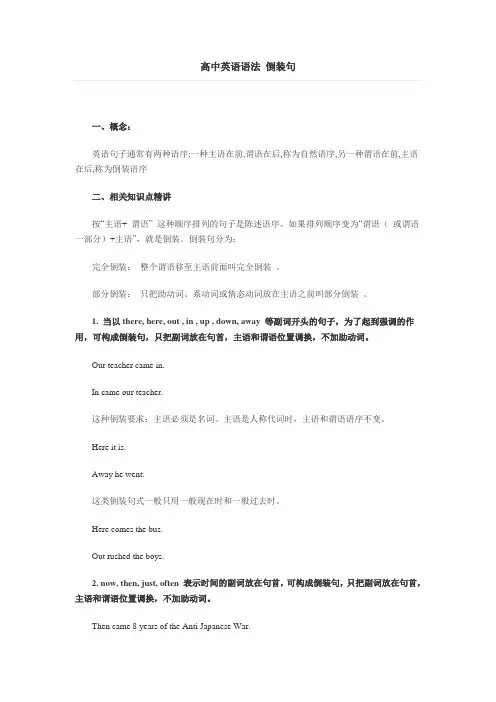
高中英语语法倒装句一、概念:英语句子通常有两种语序:一种主语在前,谓语在后,称为自然语序,另一种谓语在前,主语在后,称为倒装语序二、相关知识点精讲按“主语+ 谓语” 这种顺序排列的句子是陈述语序。
如果排列顺序变为“谓语(或谓语一部分)+主语”,就是倒装。
倒装句分为:完全倒装:整个谓语移至主语前面叫完全倒装。
部分倒装:只把助动词、系动词或情态动词放在主语之前叫部分倒装。
1. 当以there, here, out , in , up , down, away 等副词开头的句子,为了起到强调的作用,可构成倒装句,只把副词放在句首,主语和谓语位置调换,不加助动词。
Our teacher came in.In came our teacher.这种倒装要求:主语必须是名词。
主语是人称代词时,主语和谓语语序不变。
Here it is.Away he went.这类倒装句式一般只用一般现在时和一般过去时。
Here comes the bus.Out rushed the boys.2. now, then, just, often 表示时间的副词放在句首,可构成倒装句,只把副词放在句首,主语和谓语位置调换,不加助动词。
Then came 8 years of the Anti Japanese War.3. 表地点状语的介词短语放在句首,要用倒装句式,以示强调。
这种倒装句也是主谓直接调换位置,不加助动词did, does或do.Under a big tree ________, half asleep.A. did sat a fat manB. a fat man satC. did a fat man satD. sat a fat man4. there放在句首时,要用倒装句式。
在“there + be”结构中的谓语动词有时不用be , 而用表示类似“存在”观念的其他不及物动词。
如:live, stand, come, lie, flow, enter, rise 和appear等。
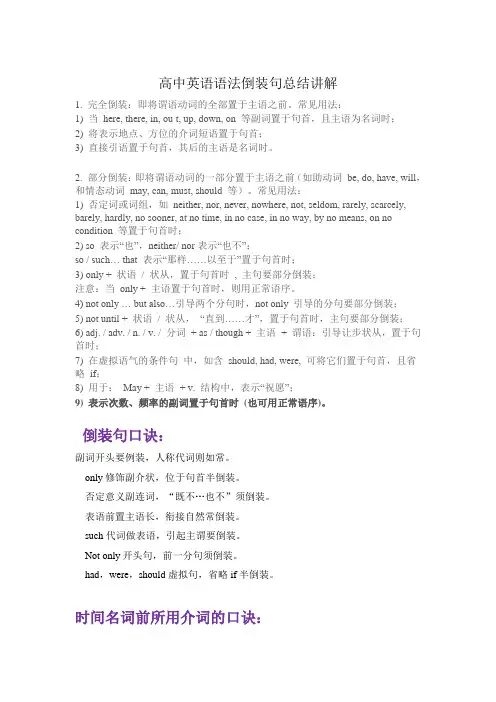
高中英语语法倒装句总结讲解1. 完全倒装:即将谓语动词的全部置于主语之前。
常见用法:1) 当here, there, in, ou t, up, down, on 等副词置于句首,且主语为名词时;2) 将表示地点、方位的介词短语置于句首;3) 直接引语置于句首,其后的主语是名词时。
2. 部分倒装:即将谓语动词的一部分置于主语之前(如助动词be, do, have, will,和情态动词may, can, must, should 等)。
常见用法:1) 否定词或词组,如neither, nor, never, nowhere, not, seldom, rarely, scarcely, barely, hardly, no sooner, at no time, in no case, in no way, by no means, on no condition 等置于句首时;2) so 表示“也”,neither/ nor表示“也不”;so / such… that 表示“那样……以至于”置于句首时;3) only + 状语/ 状从,置于句首时, 主句要部分倒装;注意:当only + 主语置于句首时,则用正常语序。
4) not only … but also…引导两个分句时,not only 引导的分句要部分倒装;5) not until + 状语/ 状从,“直到……才”,置于句首时,主句要部分倒装;6) adj. / adv. / n. / v. / 分词+ as / though + 主语+ 谓语:引导让步状从,置于句首时;7) 在虚拟语气的条件句中,如含should, had, were, 可将它们置于句首,且省略if;8) 用于:May + 主语+ v. 结构中,表示“祝愿”;9) 表示次数、频率的副词置于句首时(也可用正常语序)。
倒装句口诀:副词开头要例装,人称代词则如常。
only修饰副介状,位于句首半倒装。
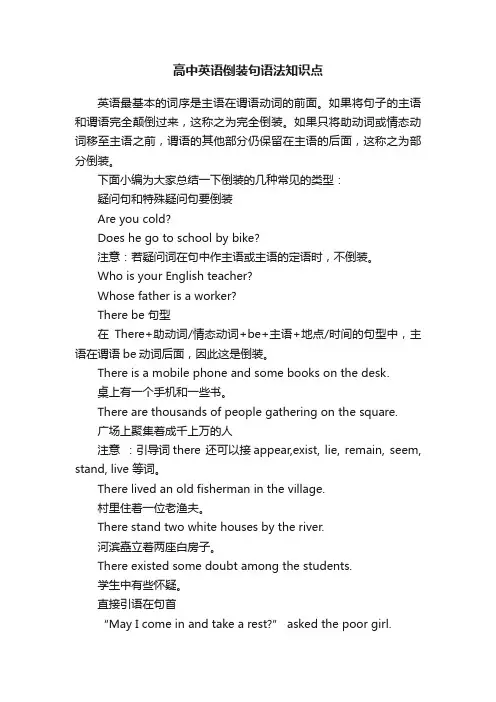
高中英语倒装句语法知识点英语最基本的词序是主语在谓语动词的前面。
如果将句子的主语和谓语完全颠倒过来,这称之为完全倒装。
如果只将助动词或情态动词移至主语之前,谓语的其他部分仍保留在主语的后面,这称之为部分倒装。
下面小编为大家总结一下倒装的几种常见的类型:疑问句和特殊疑问句要倒装Are you cold?Does he go to school by bike?注意:若疑问词在句中作主语或主语的定语时,不倒装。
Who is your English teacher?Whose father is a worker?There be 句型在There+助动词/情态动词+be+主语+地点/时间的句型中,主语在谓语be动词后面,因此这是倒装。
There is a mobile phone and some books on the desk.桌上有一个手机和一些书。
There are thousands of people gathering on the square.广场上聚集着成千上万的人注意:引导词there 还可以接appear,exist, lie, remain, seem, stand, live 等词。
There lived an old fisherman in the village.村里住着一位老渔夫。
There stand two white houses by the river.河滨矗立着两座白房子。
There existed some doubt among the students.学生中有些怀疑。
直接引语在句首“May I come in and take a rest?” asked the poor girl.“Get out of the room!” shouted the angry woman.虚拟条件句的倒装当if引导的虚拟条件从句中含有had, were, should等时,如将if 省略,则要将had, were, should等移到主语前,构成倒装句:Had you come yesterday, you would have seen him.若你昨天来,你就会见到他了。
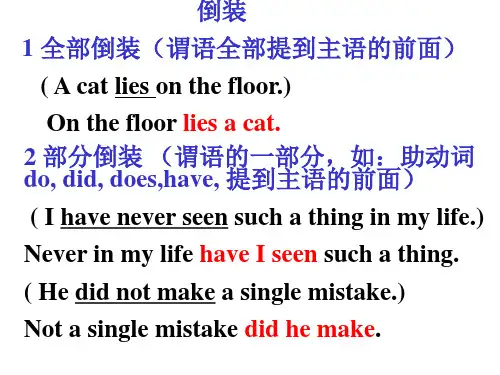

倒装句型倒装的两种形式:1. 完全倒装:谓语动词全部置于主语之前(通常只用与一般现在时和一般过去时)2. 部分倒装:将谓语的一部分即助动词提到主语前。
一、完全倒装1.here, there,now, then引导的句子,且动词常是be, go, come等。
Here comes the bus.There goes the bell.Now comes your turn. 现在轮到你了。
【辨析】当主语是人称代词时,主谓语序不变。
Here it is.In she came.2.There lie / exist / stand / live/run/remain +主语+…是there be 句型的变式,表存在。
Once there lived an old fisherman in a village by the sea.In the valley there runs a stream.Do you think there remains anything else to be done?There stands an ancient tower on the top of the mountain.3.以out, in, up, down, away, off, over, back等副词作传与并置于句首,使描述的现象更生动。
Away flew the bird.Out went the boy.Up went the prices again.4.作表语的现在分词/过去分词/形容词/介词短语+系动词+主语,突出表语,或因主语太长。
Present at the meeting were General manager and 50 workers.Facing the river is a seven-story tower.5.表示地点的介词短语置于句首,且句子主语是名词时。
Between the two buildings stands a tall tree.In south of the river lies a small factory.6.such作表语的句子,“如此的,这样的,……就是如此”Such is life!Such was the story he told me.Such were his words. 他就是这么说的.7.with引导的伴随状语放在句子开头,要进行全部倒装。
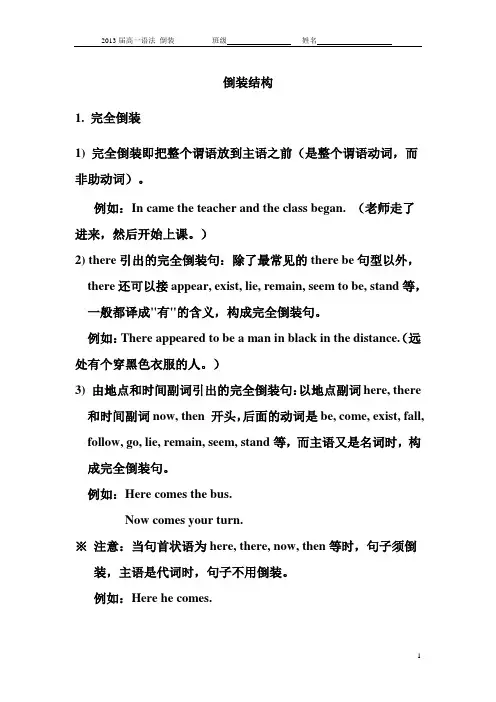
倒装结构1. 完全倒装1) 完全倒装即把整个谓语放到主语之前(是整个谓语动词,而非助动词)。
例如:In came the teacher and the class began. (老师走了进来,然后开始上课。
)2) there引出的完全倒装句:除了最常见的there be句型以外,there还可以接appear, exist, lie, remain, seem to be, stand等,一般都译成"有"的含义,构成完全倒装句。
例如:There appeared to be a man in black in the distance.(远处有个穿黑色衣服的人。
)3) 由地点和时间副词引出的完全倒装句:以地点副词here, there 和时间副词now, then 开头,后面的动词是be, come, exist, fall, follow, go, lie, remain, seem, stand等,而主语又是名词时,构成完全倒装句。
例如:Here comes the bus.Now comes your turn.※注意:当句首状语为here, there, now, then等时,句子须倒装,主语是代词时,句子不用倒装。
例如:Here he comes.4)表示运动方向的副词或地点状语置于句首,谓语表示运动的动词且主语是名词时使用完全倒装例如:Up went the plane.. the plane went up.In came the chairman.注意:如果主语是代词则不发生倒装。
例如:Out they rushed!Lower and lower he bent.5) 在直接引语之后在叙事性书面语中,直接引语后常跟asked Mary, answered John, said the old lady, grunted Peter之类的词语。
在这些词语中,动词常的主语之前。
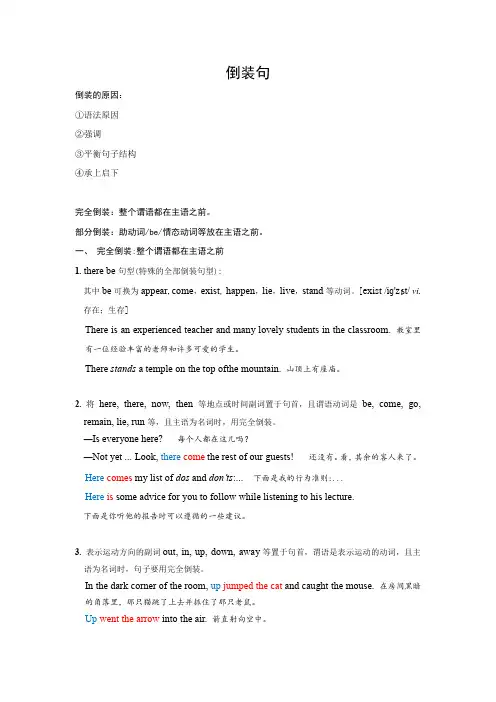
倒装句倒装的原因:①语法原因②强调③平衡句子结构④承上启下完全倒装:整个谓语都在主语之前。
部分倒装:助动词/be/情态动词等放在主语之前。
一、完全倒装:整个谓语都在主语之前1. there be句型(特殊的全部倒装句型):其中be可换为appear, come,exist, happen,lie,live,stand等动词。
[exist/iɡ'zɪst/ vi.存在;生存]There is an experienced teacher and many lovely students in the classroom. 教室里有一位经验丰富的老师和许多可爱的学生。
There stands a temple on the top ofthe mountain. 山顶上有座庙。
2. 将here, there, now, then等地点或时间副词置于句首,且谓语动词是be, come, go, remain, lie, run等,且主语为名词时,用完全倒装。
—Is everyone here? 每个人都在这儿吗?—Not yet ... Look, there come the rest of our guests! 还没有。
看,其余的客人来了。
Here comes my list of dos and don’ts:... 下面是我的行为准则:...Here is some advice for you to follow while listening to his lecture.下面是你听他的报告时可以遵循的一些建议。
3. 表示运动方向的副词out, in, up, down, away等置于句首,谓语是表示运动的动词,且主语为名词时,句子要用完全倒装。
In the dark corner of the room, up jumped the cat and caught the mouse. 在房间黑暗的角落里,那只猫跳了上去并抓住了那只老鼠。

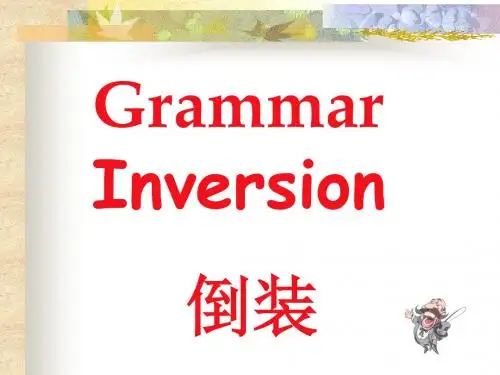
高中英语语法——倒装句一、完全倒装(full inversion)——谓语部分完全放在主语之前1. there be 句型属于完全倒装Be可以换成“stand、live、exist、lie、remain、seem、appear”2. 副词,介词放在句首,且主语是名词Here、now、then、out、in、up、down、away、behind、under、+come、follow、fall、exist、lie、go、remain、run、+主语3. 表语前置倒装形容词、分词、介词短语、such、+be+主语二、部分倒装(partial inversion)——be、助动词、情态动词放在主语之前1. only修饰副词、介词、或状语从句放句首,主句部分倒装2. 否定词、表示否定意义的短语放句首,部分倒装。
Never、nor、not、hardly、little、seldom、scarcely、rarely;at no time、in no case、by no means、on no condition、under/in no circumstance3. 固定句型①so+be、情态动词、助动词+主语=It is/was the same with;so it is/was with…也是如此②neither/nor+be、情态动词、助动词+主语=…也不这样③So+adj./adv.+助动词+主语+动词+that 如此…以至于…Such+(a/an+)adj.+n.+助+主+动词that…④Neither 助+主+动词…,nor +助+主+动词…⑤Not only +倒装,but also 正常.⑥Not until…+主句部分倒装三、形式倒装(formal inversion)——强调部分提前,主谓并不倒装1. 感叹句What a/an +形容词+名词+主语+谓语!How 形容词+a/an+名词+主语+谓语!How 形容词/副词+主语+谓语!2. the more…,the more….The harder you work,the greater progress you have.3. however/whatever 引导的让步状语从句However difficult the problem may be,we must work it out this evening。
高中英语语法倒装句谓语或谓语的一部分放在主语之前的语法现象,就称之为倒装。
从倒装的形式来看,可分为完全倒装和部分倒装两大类。
前者是指整个谓语置于主语之前,而而后者仅指助动词、情态动词或be动词等置于主语之前。
一. 完全倒装完全倒装又可称为全部倒装。
完全倒装是只将句子中的谓语动词全部置于主语之前。
此结构通常只用于一般现在时和一般过去时。
常见的结构有:(1)here,there,now,then,thus等副词置于句首,谓语动词常用be,come,go,lie,run等表示来去或状态的动词。
例如:Then came the teacher. 那时老师来了。
Here is your letter. 你的信。
(2)表示运动方向的副词或地点状语置于句首,谓语表示运动的动词。
例如:Ahead sat an old woman. 前面坐着一个老大妈。
注意:上述全部倒装句型结构的主语必须是名词,如果主语是人称代词则不能完全倒装。
例如:Here he comes. 他来了。
Away they went. 他们走开了。
二. 部分倒装部分倒装是指将谓语的一部分如助动词或情态倒装放到主语之前。
如果句子的谓语没有助动词或情态动词,则需添加助动词do,does 或did,并将其置于主语之前。
(1)句首为否定或半否定的词语,如no, not, never, seldom, little, hardly, at no time, in no way, not until…等。
例如:Never have I seen such a performance.从未见过如此糟糕的表演。
Nowhere will you find the answer to this question.无论如何你不会找到这个问题的答案的。
Not until the child fell asleep did the mother leave the room.母亲一直到孩子入睡后才离开房间。
倒装句一、全部倒装全部倒装即把整个谓语部分放在主语之前。
当副词here, there, in, out, up, down, away, back, then, ahead, off, over等位于句首、谓语动词常为be, come, go, follow, run, rush, fly, fall等不及物动词,而且主语又是名词时,用完全倒装。
注意:此类倒装只限于一般现在时和一般过去式,不用进行时态并且若主语是代词时,不用倒装。
同学们可借助下面的图形速记用于完全倒装的词。
1.介词短语(地点状语)+不及物动词+主语Under the tree sits a beautiful girl.=A beautiful girl sits under the tree. 树下坐着一位漂亮的女孩。
South of the lake lies a big supermarket. 湖泊的南边是一个大超市。
20 miles east of our school lies a modern swimming pool. 我们学校向东20英里有一个现代化的游泳池。
On the floor were piles of old books, magazines and newspapers. 地板上是一堆堆旧的书报杂志。
2.表方向、地点的副词(here, there, up, down, away)+不及物动词+主语,构成的全部倒装句Hearing the dog barking fiercely, away fled the thief. 听到狗的狂叫声,小偷逃掉了。
Here comes the bus. 公交来了。
There goes the bell. 铃响了。
3.“主+系+表”结构如强调表语通常转化为“表+系+主”(表语通常为形容词、现在分词和过去分词)的全部倒装句。
Happy are those who are contented. =Those who are contented are happy. 知足常乐。